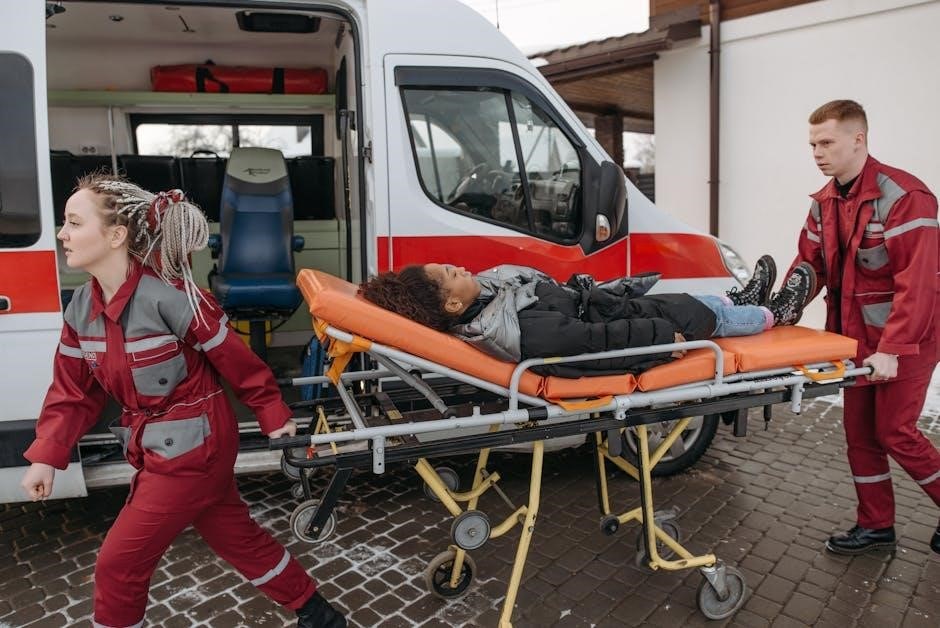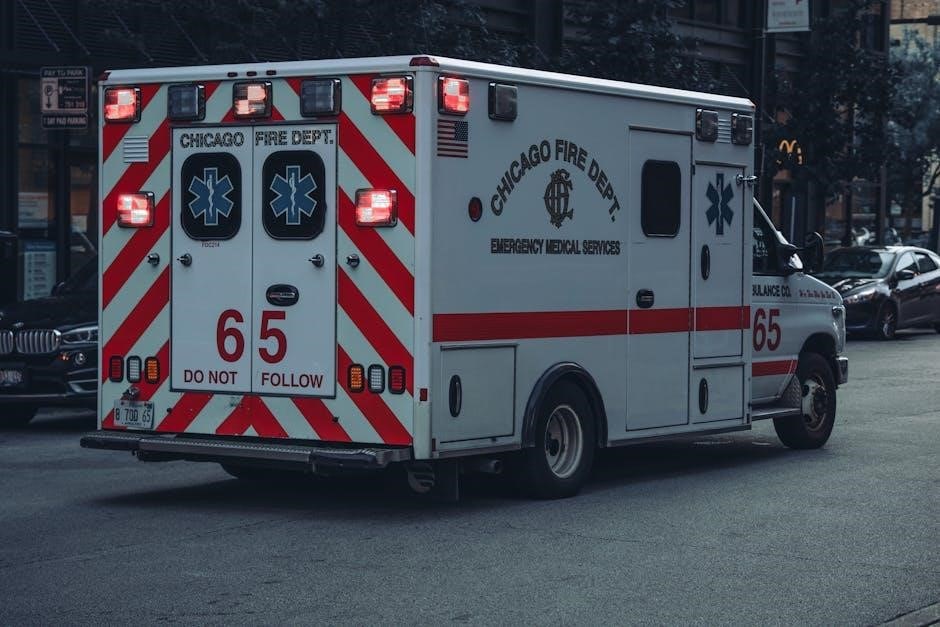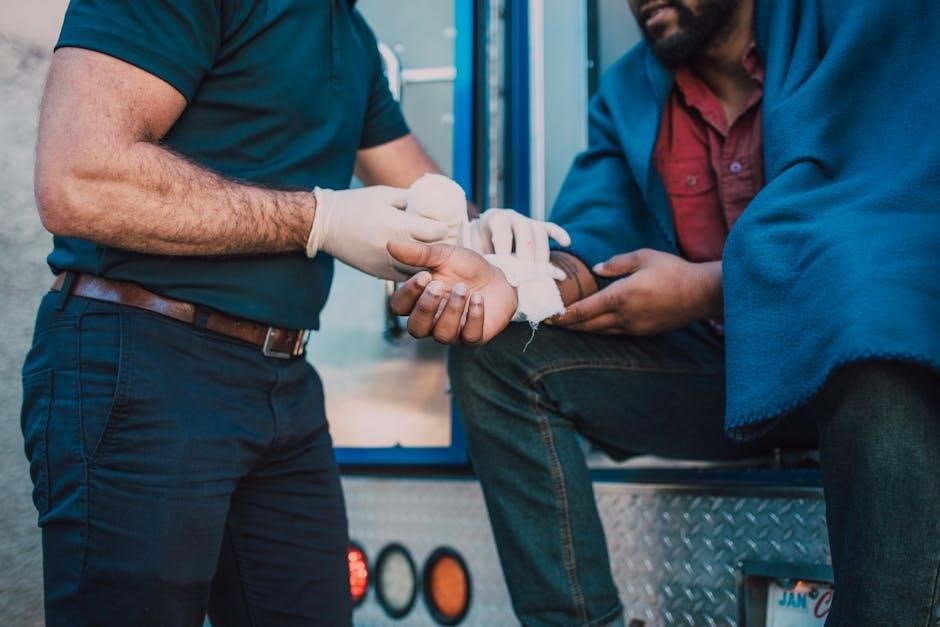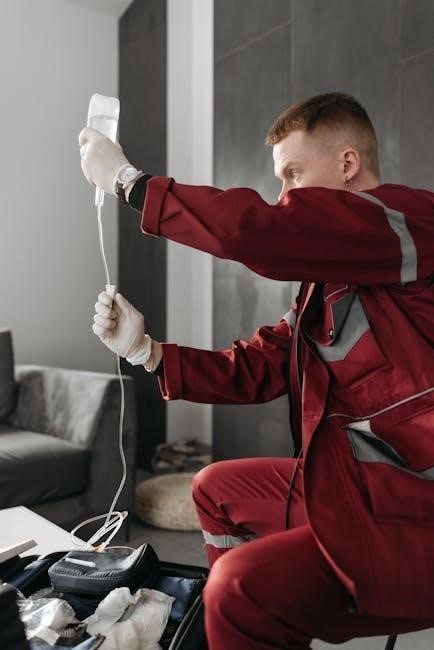The USMLE Step 2 CS assesses clinical skills through patient encounters, emphasizing communication, physical exams, and documentation. First Aid for USMLE Step 2 CS is a trusted guide, offering high-yield strategies and case simulations to help students excel in this critical exam.
Overview of the Exam
The USMLE Step 2 CS evaluates clinical skills through real-time patient interactions. It assesses communication, physical examination techniques, and the ability to document findings accurately. The exam uses standardized patients (SPs) to simulate clinical scenarios, requiring candidates to demonstrate patient-centered care. The format includes 10-12 encounters, each lasting 15 minutes, with a post-encounter notes section. The exam is pass/fail, emphasizing practical skills over theoretical knowledge. Resources like First Aid for USMLE Step 2 CS provide high-yield strategies and case simulations to help candidates master these clinical competencies effectively.
Importance of Clinical Skills Assessment
The USMLE Step 2 CS plays a critical role in ensuring medical graduates can interact effectively with patients, demonstrating empathy and professionalism. It evaluates essential clinical skills like history-taking, physical exams, and communication, all of which are vital for patient care. The exam’s focus on standardized patient encounters mirrors real-world clinical scenarios, ensuring candidates are prepared to practice safely and effectively. Resources like First Aid for USMLE Step 2 CS help students master these skills, emphasizing the importance of patient-centered care and accurate documentation in medical practice.

Evolution of USMLE Step 2 CS
The USMLE Step 2 CS has undergone significant updates, reflecting advancements in medical education and clinical practice. First Aid for USMLE Step 2 CS aligns with these changes, ensuring relevancy.
Historical Context and Exam Format Changes
The USMLE Step 2 CS was introduced to evaluate clinical skills, emphasizing patient interaction and decision-making. Over time, the exam format has evolved, incorporating feedback from test-takers. The sixth edition of First Aid for USMLE Step 2 CS reflects these changes, aligning with the NBME’s updated format and worksheet items. It includes new clinical cases and strategies, such as telephone encounters and special patient scenarios. This evolution ensures the exam remains relevant to real-world clinical practice, while the guide provides a comprehensive preparation tool for success.
Impact of Recent Updates on Exam Preparation
Recent updates to the USMLE Step 2 CS exam, such as new clinical cases and exam formats, have shifted preparation strategies. First Aid for USMLE Step 2 CS has adapted by incorporating feedback from test-takers, ensuring alignment with current exam standards. The guide now emphasizes patient-centered interviews and high-yield content, helping students focus on frequently tested scenarios. These updates have made the resource indispensable for effective preparation, enabling examinees to navigate changes confidently and perform at their best on exam day.

Key Features of First Aid for USMLE Step 2 CS
First Aid for USMLE Step 2 CS offers high-yield content, updated exam strategies, and feedback from recent test-takers. It provides proven techniques for clinical encounters and patient-centered interviews.
High-Yield Content and Organization
First Aid for USMLE Step 2 CS is renowned for its concise, high-yield content, meticulously organized to cover essential clinical scenarios and skills. The guide focuses on patient-centered interviews, physical exams, and documentation, with clear sections for communication skills and differential diagnoses. It integrates feedback from recent test-takers, ensuring relevance and practicality. The book’s structured format allows for efficient review, emphasizing frequently tested cases and simulation-based learning. Abbreviations and mnemonics are included to aid memorization, while real-life examples enhance understanding of clinical problem-solving and exam strategies.
Updated Exam Strategies and Feedback Integration
First Aid for USMLE Step 2 CS incorporates feedback from recent US and international test-takers, refining its exam strategies to reflect current NBME formats. The guide emphasizes patient-centered interviewing techniques, time management, and effective note-writing. It includes proven approaches for handling challenging scenarios, such as telephone encounters and special cases. Updated content addresses common blind spots, offering practical tips to avoid mistakes. By integrating real examinee insights, the book provides tailored advice, ensuring students are well-prepared for the evolving exam landscape and improving their chances of success.

Study Strategies for USMLE Step 2 CS Success
Mastering patient-centered interviews, using First Aid for USMLE Step 2 CS abbreviations, and practicing high-yield cases are key strategies for exam success.
Mastering Patient-Centered Interviews
First Aid for USMLE Step 2 CS emphasizes the importance of patient-centered interviews, focusing on effective communication and empathy. Students are advised to start with open-ended questions, gradually narrowing to specific details. Confirming the patient’s name and preferred form of address is crucial. The guide highlights the value of active listening and validating patient concerns. Proper documentation of findings using concise and clear language is also stressed. By mastering these techniques, examinees can demonstrate strong clinical skills and build rapport, ensuring a high score in the patient-physician interaction component of the exam.
Effective Use of Abbreviations and Mnemonics
First Aid for USMLE Step 2 CS highlights the importance of using approved abbreviations and mnemonics to streamline patient encounters and documentation. These tools enhance efficiency and accuracy, particularly during high-pressure exams. The guide provides high-yield mnemonics to remember complex clinical concepts and standardized abbreviations from the exam orientation materials. By mastering these strategies, examinees can save valuable time and ensure clear, concise communication. This approach not only improves performance but also aligns with the exam’s expectations, making it a key component of successful preparation for both Step 2 CS and CK.

Commonly Tested Clinical Cases
First Aid for USMLE Step 2 CS thoroughly covers frequently tested cases, such as respiratory distress, cardiovascular issues, and neurological disorders. It provides high-yield simulations and strategies for handling these scenarios effectively, ensuring students are well-prepared for common clinical encounters, including telephone cases and special patient interactions.
Frequently Encountered Scenarios in the Exam
First Aid for USMLE Step 2 CS highlights scenarios like respiratory distress, cardiovascular issues, and neurological disorders. It provides strategies for patient-centered interviews, physical exams, and documentation. Students learn to navigate telephone cases, pediatric encounters, and sensitive topics like substance abuse. The guide emphasizes effective communication, differential diagnoses, and concise patient notes, ensuring readiness for diverse clinical challenges. By simulating real exam conditions, it helps build confidence and competence in handling high-stakes cases, aligning with the exam’s focus on practical clinical skills.
Telephone Encounters and Special Cases
The USMLE Step 2 CS includes telephone encounters, testing communication skills without visual cues. First Aid provides strategies for handling these cases, emphasizing active listening and clear documentation. Special cases, such as pediatric exams or psychiatric evaluations, require tailored approaches. The guide offers tips for managing sensitive topics, like substance abuse or end-of-life discussions, ensuring students are prepared for diverse clinical challenges. Practice cases and feedback tools help refine these skills, fostering confidence in high-pressure scenarios and improving overall exam performance.

Biostatistics and Clinical Knowledge
Biostatistics are crucial for interpreting medical data and making clinical decisions. First Aid highlights key concepts, ensuring a strong foundation in evidence-based medicine and its application in patient care scenarios.
Relevance of Biostats to Step 2 CS
Biostatistics plays a pivotal role in USMLE Step 2 CS, as it underpins evidence-based medicine and clinical decision-making. Understanding concepts like sensitivity, specificity, and likelihood ratios is essential for interpreting diagnostic test results. First Aid for USMLE Step 2 CS emphasizes high-yield biostatistics topics, ensuring students can apply these principles to real patient scenarios. This knowledge is critical for generating accurate differential diagnoses and treatment plans, making it a cornerstone of clinical competence assessed in the exam.
Overlap with Step 1 and Step 2 CK Content
The USMLE Step 2 CS shares a significant overlap with Step 1 and Step 2 CK content, particularly in areas like pharmacology and pathophysiology. First Aid for USMLE Step 2 CS highlights these connections, helping students integrate their knowledge seamlessly. For instance, understanding disease mechanisms from Step 1 complements the clinical presentations in Step 2 CS. Similarly, the diagnostic reasoning and management strategies from Step 2 CK align with the patient encounters in CS, ensuring a cohesive preparation approach across all exams;

Exam-Day Preparation Tips
Ensure a final review of high-yield content, stay calm, and arrive early. Organize materials, practice time management, and maintain a positive mindset for optimal performance.
Final Review and Mental Readiness
Conduct a thorough final review of high-yield content, focusing on frequently tested clinical cases and documentation skills. Ensure mental readiness by practicing relaxation techniques and maintaining a positive attitude. Review the First Aid for USMLE Step 2 CS guide to reinforce key strategies and simulate exam conditions. Organize your materials, arrive early, and stay calm to optimize performance. Mental preparation is crucial for navigating the exam confidently and effectively.
Logistical and Time Management Strategies
Plan your travel and accommodations well in advance to avoid last-minute stress. Familiarize yourself with the test center location and arrival procedures. Allocate time for final review without overloading your schedule. Utilize the First Aid for USMLE Step 2 CS guide to simulate exam conditions and refine your case documentation. Prioritize tasks, such as reviewing high-yield cases and practicing patient encounters. Ensure your materials are organized, and arrive early to maintain composure. Effective time management and logistical preparation are key to a smooth exam experience.

Feedback from Recent Test-Takers
Recent examinees praise the updated First Aid for USMLE Step 2 CS for its high-yield content and practical strategies, emphasizing improved preparation for clinical encounters and exam success.
Insights from US and International Examinees
Both US and international examinees highlight the value of First Aid for USMLE Step 2 CS in preparing for the exam. The guide’s high-yield content and practical strategies resonate well with test-takers, helping them navigate clinical encounters effectively. Many appreciate the inclusion of feedback from recent examinees, which provides real-world insights and tips for success. The updated sixth edition is particularly praised for its alignment with the latest NBME format, ensuring candidates are well-prepared for the challenges of the exam. This collective feedback underscores the resource’s role in bridging gaps in clinical skills assessment.
Common Blind Spots and Mistakes to Avoid
Many candidates overlook the importance of patient-centered communication, often rushing through interviews without addressing patient concerns. Another common mistake is inadequate documentation, as failing to write clear, concise notes can significantly impact scores. Time management is also a frequent issue, with examinees either spending too much time on a single case or running out of time for others. Additionally, some candidates neglect to practice with standardized patients (SPs), leading to unrealistic expectations during the exam. These blind spots highlight the need for thorough preparation and practice to avoid costly errors on exam day.

Role of Standardized Patients (SPs)
Standardized Patients (SPs) are trained laypersons who simulate clinical scenarios, providing realistic encounters for examinees. They assess communication, physical exam skills, and professionalism, ensuring a consistent evaluation experience.
Simulation of Clinical Problems
Standardized Patients (SPs) are trained to simulate a wide range of clinical scenarios, mimicking real patient encounters. These simulations assess a candidate’s ability to gather histories, perform physical exams, and communicate effectively. The SPs are coached to present consistent symptoms and responses, ensuring a standardized evaluation. This setup allows examinees to demonstrate their clinical skills in a controlled environment, providing a realistic preview of patient interactions. The use of SPs ensures that the exam objectively measures competence in patient-centered care and problem-solving. This approach is critical for evaluating readiness for real-world clinical practice.
Training and Realism in SP Encounters
Standardized Patients (SPs) undergo rigorous training to simulate realistic clinical encounters. They are taught to portray specific medical conditions, ensuring consistent and accurate portrayals. The training emphasizes realistic patient behaviors, including verbal and non-verbal cues, to mimic real-life interactions. This realism allows examinees to practice and demonstrate their clinical skills in an environment that closely mirrors actual patient care. The encounters are designed to test a candidate’s ability to respond appropriately to diverse clinical scenarios, ensuring a comprehensive assessment of their readiness for real-world medical practice.

Supplemental Resources for Exam Prep
Supplement your preparation with recommended question banks and online forums. Utilize guides for practical exam strategies and high-yield content to enhance your study routine.
Recommended Question Banks and Study Materials
For effective preparation, utilize UWorld for realistic case simulations and Kaplan for interactive learning tools. The First Aid for USMLE Step 2 CS guide is indispensable, offering high-yield content and updated strategies. Complement your studies with online forums and community insights to stay informed. These resources collectively provide a robust foundation for mastering clinical skills and excelling on exam day, ensuring you are well-prepared for the challenges of the USMLE Step 2 CS.
Complementary Guides for Comprehensive Preparation
Beyond First Aid for USMLE Step 2 CS, complementary guides like Kaplan and UWorld offer invaluable resources. Kaplan’s QBank provides realistic practice questions, while UWorld’s case simulations mirror actual exam scenarios. Online forums and community insights further enhance preparation by sharing tips and common pitfalls. These guides, when used alongside First Aid, create a well-rounded study strategy, ensuring a deeper understanding of clinical encounters and exam expectations. Together, they equip students with the tools needed to excel in the USMLE Step 2 CS exam.
Mastering clinical skills and exam strategies is key to success. Thorough preparation with resources like First Aid for USMLE Step 2 CS ensures confidence and excellence in the exam.
Final Thoughts on Maximizing Exam Performance
Thorough preparation is essential for excelling in the USMLE Step 2 CS. Utilizing resources like the updated First Aid for USMLE Step 2 CS ensures a strategic approach. Focus on high-yield content, practice patient-centered interviews, and master documentation skills. Incorporate feedback from recent test-takers to refine your strategies. Stay updated on exam format changes and biostatistics relevance; A well-organized study plan, coupled with realistic SP encounters, will enhance your confidence. Remember, consistent practice and mental readiness are key to achieving success in this critical exam.
Encouragement for Thorough Preparation
Preparing for the USMLE Step 2 CS requires dedication and a well-structured approach. First Aid for USMLE Step 2 CS is an invaluable resource, offering high-yield content and real-life case simulations. By thoroughly reviewing this guide, practicing patient interactions, and mastering documentation, you can build confidence and competence. Stay organized, focus on weak areas, and maintain a positive mindset. Consistent effort and adherence to proven strategies will significantly enhance your performance. Remember, thorough preparation is the cornerstone of success in this exam.
